I love gardening and have heard many wrong ideas about growing tomatoes. Research says many people are into growing tomatoes at home because store-bought ones are not as good.
But believing in these myths might be stopping your garden from doing its best.
I’m here to clear up 9 common tomato myths. I’ll also give tips from the experts. They will help you grow healthy, tasty tomatoes easily.
One big myth is that tomatoes need the sun all day. But it’s not true. Most tomatoes are fine with just six to eight hours of sun. They should be planted in rows from north to south.
A lot of people think tomatoes must ripen on the vine for the best taste. But, those in pots can ripen for up to two weeks. That’s because the soil in pots warms up faster.
Key Takeaways
- Tomatoes don’t need full sun all day to thrive; 6-8 hours is sufficient.
- Container-grown tomatoes can ripen faster than those in the ground.
- Pruning and aggressive fertilizing are not essential for great tomatoes.
- Tomatoes are ripe when they reach their true colour and soften, not just when they turn red.
- Proper planting depth is key for healthy tomato plants.
You Have to Let Tomatoes Ripen on the Vine for Good Flavor
Many think tomatoes need the vine to be fully ripe for the best taste. But, that’s not quite true. Tomatoes are at their best just before fully ripe. If bugs are an issue, pick them when they’re turning and finish indoors in a cool, dark spot.
The idea that tomatoes must be on the vine to taste great is a myth. There are over 10,000 tomato, making them very common in gardens. False info about growing tomatoes can hurt their health and how much they produce.
Tomatoes can ripen evenly without the sun because of changes inside them. They best ripen at 68–77 F (20-25 C) and slow down in hotter or colder weather. Cutting off some branches can make the plant focus on making fruit instead of leaves.
| Tomato Ripening Stages | Duration | Characteristics |
|---|---|---|
| Mature Green | 40 – 50 days | Fruit is fully grown but has no color |
| Breaker | 2 – 7 days | 10-30% of the surface shows pink color |
| Full Ripeness | 2 – 7 days | Fruit is fully red and ready to eat |
Deciding on vine or early ripening matters less than how you store them. Store at room temp with air lets them lasts longer. Knowing the right ways helps you always get the perfect tomato taste.
So, the vine ripening myth isn’t true. With the right care, your tomatoes will taste great whether you pick them early or late.
Use Aspirin Spray for Healthier, More Pest-Resistant Tomatoes
Gardeners often hear that aspirin makes tomatoes better. They think aspirin keeps pests away and makes the plants strong. But, science doesn’t fully back this idea. Aspirin’s power for plants is real, but it may not fight off bugs or diseases in tomatoes.
Scientists have found aspirin isn’t a perfect plant protector. It can change quickly and may harm plants. Some studies say aspirin helps tomato plants grow well and makes more fruit. Yet, others saw no big difference in getting sick or the amount of harvest.
Gardeners do best when they give tomatoes what they really need. Tomatoes love sun, water, and good food. When their needs are met, they grow strong and avoid bugs. So, it’s good to stick to simple, proven ways to help plants.
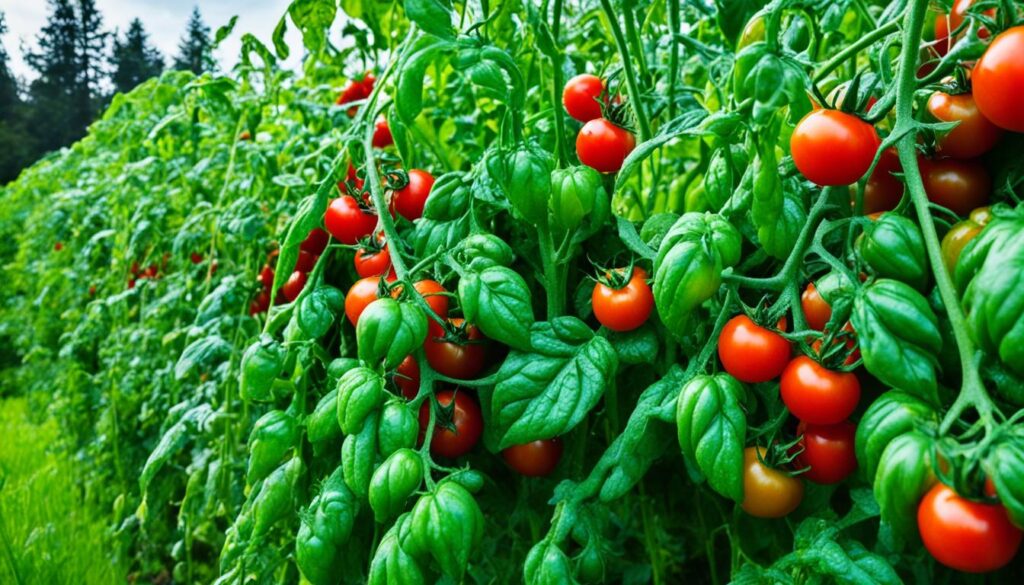
Some home tricks might sound good but often don’t work for real. For the best tomatoes, listen to advice that’s been checked by science. This way, you won’t waste time on things that might not help. Good care and real advice can make tomato plants do great.
You Have to Grow Paste Tomatoes for Sauce
Many gardeners think only paste tomato varieties, such as Roma, work for sauce. But any tasty tomato can make a great sauce. Paste tomatoes, with their low moisture, are easy to use. Yet, slicing or cherry types are also excellent with more preparation.
Growing paste tomatoes for sauce involves several key points. While Amish Paste and Roma were top choices, new hybrids like Invincible stand out now. Whereas the famous San Marzano is great for sauce, it might face issues like Blossom End Rot in some cases.
Aside from the usual paste types, many others are great for sauce. San Marzano and Sausage are known for their meaty flesh, which is perfect for canning. Black Prince and Saucey have a great balance for salsa. Viva Italia, with its zest, is good for cooking or freezing.
To make the top-notch sauce, the tomato kind matters, but so does the growing method and care for the plants. Proper watering and watching for issues like Blossom End Rot is key. By using good tips and trying different tomatoes, gardeners can make a sauce that stands out.
| Tomato Variety | Characteristics | Best Use |
|---|---|---|
| San Marzano | Flavorful, meaty, few seeds | Canning, sauce-making |
| Sausage | Flavorful, meaty, few seeds | Canning, sauce-making |
| Black Prince | Balanced, meaty, bold flavor | Salsas |
| Saucey | Balanced, meaty, bold flavor | Salsas |
| Viva Italia | Fresh, zesty flavor | Canning, cooking, freezing |
Over two decades of testing and growing more than 100 varieties of tomatoes helped broaden the perspective on paste tomatoes.
Leaves Falling Off Your Plant Is a Sign of Disease
Some people think if the tomato leaves turn yellow and drop, it’s sick.
But actually, it happens as the plant grows. It moves from making leaves to making fruit.
As it grows and the weather gets warmer, the old leaves fall off because they don’t get enough sunlight. It’s just nature, not a problem. Adding more water or fertilizer won’t help.
The plant losing leaves is just part of its cycle. Tomato plants show disease in many ways, not just by dropping leaves. Instead, give them good mulch, support, and gardening tips for their health and growth.
“The loss of leaves is a natural progression as the plant redirects its energy towards fruit production.”
Knowing tomato plants change over time helps you not worry. Instead, focus on making their environment great. Then, you’ll pick yummy tomatoes soon.
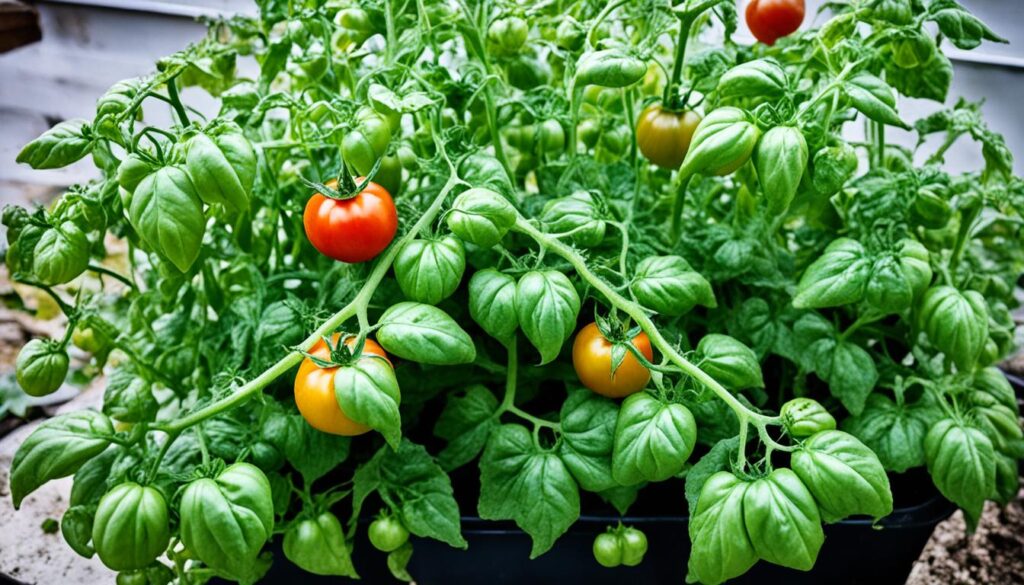
Not every time leaves fall, it’s a big problem. Look at the whole plant. Fast action on any worries helps your tomatoes do well. With the right steps, you’ll have a great tomato season.
You Should Always Prune Off Suckers
Tomato growers often wonder about cutting off suckers or not. Some say it’s best to remove these smaller side branches to have a single-stem main plant. Yet, many don’t prune at all. The choice depends on your tomato variety and what you want from your garden.
Cutting the suckers can mean bigger tomatoes but less of them. Leaving them might give you more but smaller fruits. A lot of gardeners, though, choose something in between – they leave two or three stems instead of just one.
In colder places, keeping the side shoots might help tomatoes ripen sooner. But, removing them can lower the chance of sickness by allowing the air to flow freely. Your fruits might also be safer from bugs.
The choice to prune suckers really is up to you. Some think that cutting them makes the fruit taste better and ripen early, while others like the extra fruit from unpruned plants. Try different ways and see what’s best for you and your garden goals.
The Pros and Cons of Pruning Tomato Suckers
| Pruning Suckers | Leaving Suckers |
|---|---|
| Larger, fewer tomatoes | Smaller, more numerous tomatoes |
| Improved air circulation, reducing disease risk | Increased disease potential due to crowded leaves |
| Easier to access fruit, deterring pests | More leaves for better photosynthesis and flavor |
| Faster maturation in cooler climates | Faster maturation in cooler climates |
| Allows for more plants per square yard | No need to remove healthy stems |
Both sides of the pruning argument have value. The best way depends on your growing space, tomato type, and what you want from your plants. Experiment to see what works for you and your garden.
Tomatoes are Heavy Feeders
Many people think tomatoes need a lot of food, but this is not always true. They do benefit from extra nutrients, especially early on. But, they are okay with less if the soil is good. Too much food can cause a problem. It can cause the plant to grow too many leaves and produce less fruit.
Being careful with how much you feed your tomato plants is important. Things like compost can give the plants what they need. The right soil acidity is also crucial for the plants to use food well. You should test the soil every few years to check its health.
Tomatoes do need a lot of sunlight, at least 6 to 8 hours a day. But they can grow in different soils too. Some types, like Celebrity and Moskvich, do well in cold and foggy areas. Others, like the Big Dwarf, are perfect for pots.
To feed your tomatoes right, find the best nutrient mix and keep the soil healthy. Don’t give them too much fertilizer. Use natural stuff and test the soil to help your plants grow strong without too much food. Doing this, you can have plenty of tomatoes without too hard work.
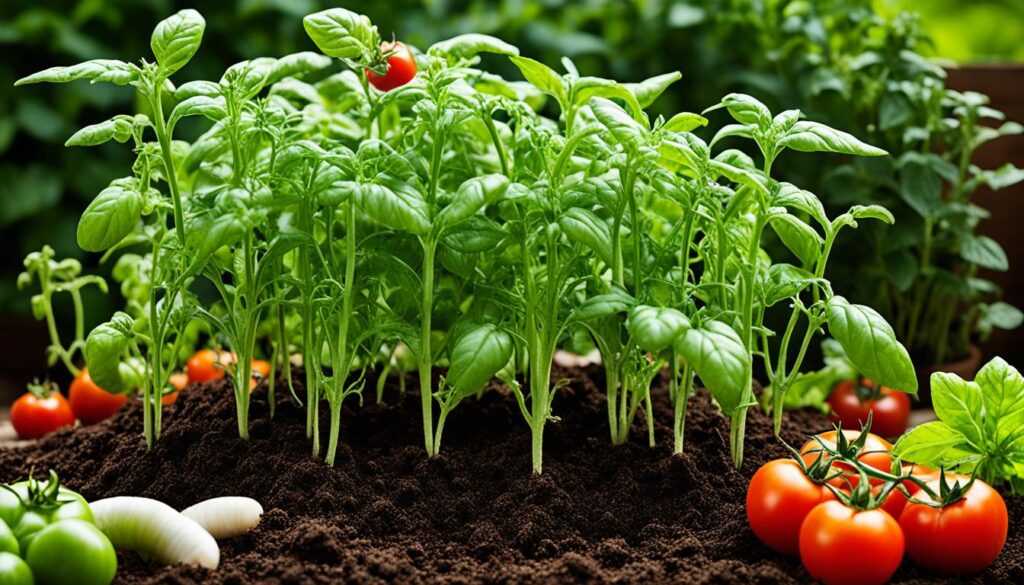
| Tomato Variety | Growth Habit | Fertilizer Needs |
|---|---|---|
| Determinate | Bushier, 3-4 feet tall | Lower, may not need support |
| Indeterminate | Taller, 6-12 feet tall | Higher, require heftier support |
| New Big Dwarf | Compact, 2 feet tall | Moderate, can grow in containers |
Determinate tomatoes usually need less food than indeterminate ones. The New Big Dwarf is good for containers with a bit more feeding.
“Fertilizing tomatoes with a higher phosphorus than nitrogen fertilizer is recommended only when fruit appears, especially in well-amended soils.”
Tomatoes seem to need a lot, but you can do well with the right soil and food plan. It’s key to watch your plants and make changes as needed.
Adding Eggshells to the Soil Will Prevent Blossom End Rot
Many believe putting eggshells by tomato plants can stop blossom end rot. This issue makes the fruit’s bottom rot. While eggshells add calcium to the soil for tomatoes, they might not stop rot.
Blossom end rot comes from not enough water or calcium in the plant. Giving tomatoes enough water helps them use the calcium better. Keeping the soil’s pH from 6.5 to 7.0 also helps plants grow well and absorb calcium.
Eggshells provide calcium only after they break down with help from tiny organisms. Adding them to compost makes the soil better. However, eggshells alone won’t fully stop blossom end rot.
To keep tomatoes healthy and stop blossom end rot, do soil tests often. Make sure the soil stays moist and balances any missing nutrients. Just using eggshells isn’t enough to fix this problem.
| Myth | Reality |
|---|---|
| Adding eggshells to the soil will prevent blossom end rot. | Eggshells can provide calcium, but they are not a reliable solution for preventing blossom end rot. Consistent watering and maintaining soil pH are more effective approaches. |
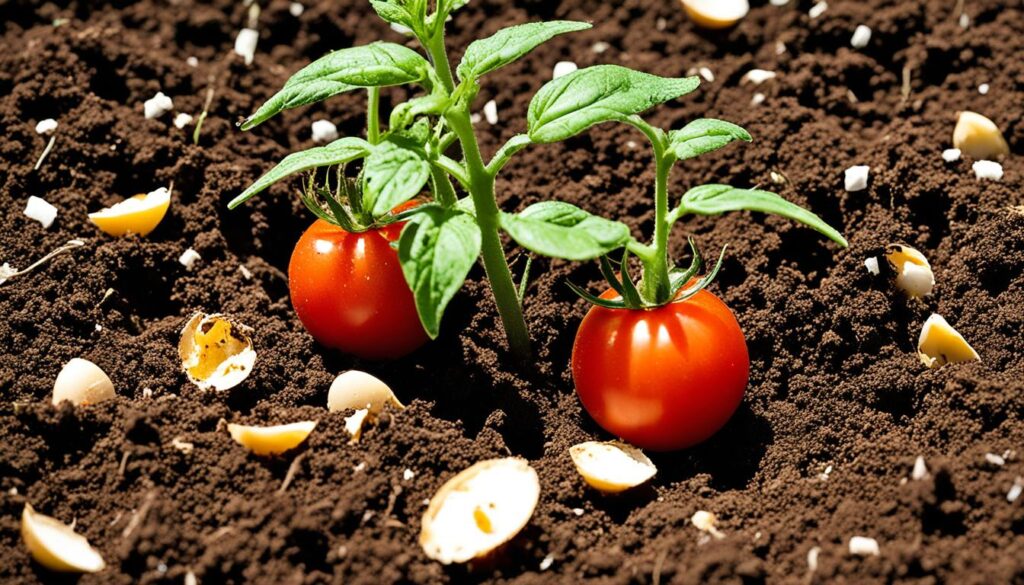
“Eggshells are a rich source of calcium carbonate, but they need to be composted or crushed to make the minerals available to plants. Simply adding whole or crushed eggshells to the soil is unlikely to prevent blossom end rot on its own.”
Eggshells are good for gardens but not a fix-all for rot in tomatoes. It’s better to focus on regular watering, checking soil pH, and balancing nutrient needs. This helps your tomato plants be strong and make good fruit.
You Have to Ferment Tomato Seeds If You’re Going to Save Them
Many gardeners think fermenting tomato seeds is key if you want to plant them next season. It’s a traditional way to get rid of a slimy layer and help them grow better. But it’s not always needed. Tomato seeds can still grow well the next year if you dry them right and keep them in a cool, dry spot without fermenting.
Fermentation means letting the seeds sit in a mushroom for 48 hours up to a week. This can make some seeds not grow as well. You could also rub each seed on a paper towel.
This takes off the gel and flesh but is a lot of work when you have a lot of seeds.
Or, you can choose the “Do Nothing” way. Just wash them in water, let them air dry with the gel and flesh, and then plant them. This method works, too, even though it might seem like the flesh would stop them from growing.
An experiment tried three ways to grow seeds: fermenting, rubbing, and doing nothing. All three ways had 100% of the seeds grow. The seeds became good plants. This means the flesh and gel on the seeds might not really stop them from growing. But, the rubbing method is best for a few seeds. Fermenting is easier for many seeds and might make them safer to plant.
Most experts say to ferment tomato seeds before winter storage. Yet, some studies show seeds that aren’t fermented often grow better. So, maybe fermenting seeds isn’t always the best thing.
Your choice on fermenting seeds depends on what you want and need for your garden. Whatever you pick, be sure to dry and store your seeds well. This helps them grow into healthy tomato plants later.
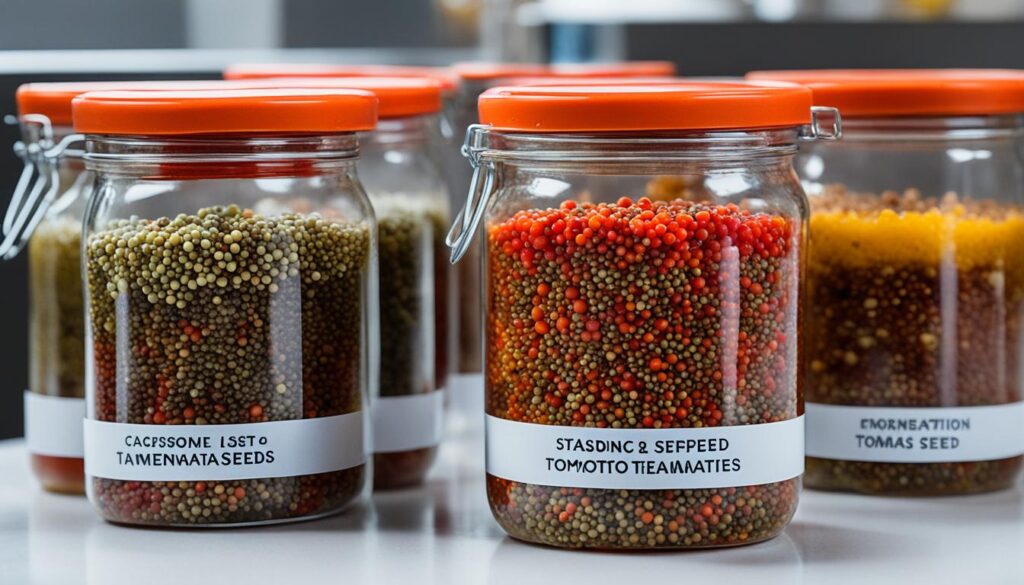
Saving tomato seeds helps keep a variety of tomatoes around. It’s best to ferment them in warmth, away from the sun, for 2-3 days. This breaks down things that can stop them from growing. Seeds that don’t float are good to keep.
The type of tomato you choose changes what the plants will be like. Seeds from stores might not grow the same. However, seeds from special markets might make new types by mixing them with other plants.
The choice to ferment your seeds is yours. You can pick the old way or a new one. The main thing is to save seeds from your best tomatoes. This way, you’ll have a lot of tasty tomatoes next time.
Don’t Refrigerate Your Tomatoes
Yes, cold can make tomatoes lose flavor and become. But you can still keep ripe tomatoes in the fridge. When you do, let them warm up. It will bring back their taste.
Ripe tomatoes taste best in 2 to 3 days at room temp. They can stay in the fridge for 3 days without losing much. But remember, taste buds like sweets are better warm.
Mealy tomatoes are usually from how they are grown, not being cold. Cold or room temp tomatoes can taste. But never put unripe ones in the fridge. Following this advice, you can savour tasty tomatoes, garden-fresh or chill stored.
FAQ About Popular Tomato Growing Myths
Do you have to let tomatoes ripen fully on the vine for the best flavour?
Tomatoes don’t have to ripen on the vine for great tastefully. You can pick them up early and let them finish ripening indoors. This is useful if animals eating them is a problem.
Will spraying tomato plants with aspirin make them more pest-resistant and healthier?
There is no proof spraying tomatoes with aspirin helps. It’s better to focus on giving your plants enough sunlight, water, and nutrients. This will help them be strong and healthy.
Can you only use paste tomato varieties, like Roma, to make homemade tomato sauce?
No, you can use any tasty tomato for sauce. Paste tomatoes are easier because they have less water. But, other types like slicers or cherries work too, although they take longer to cook down.
Is it a problem if the leaves on your tomato plant start to turn yellow and fall off?
No, it’s part of a tomato plant’s natural cycle. As the plant grows and produces fruit, older leaves might turn yellow. This is normal. It doesn’t mean you need more water or fertilizer.
Should you always prune off tomato suckers (side shoots) for the best results?
Deciding to prune tomato suckers is up to you. Leaving them might grow a bushier plant with smaller tomatoes. Pruning can give you fewer but bigger tomatoes. It depends on your choice and the space you have.
Do tomatoes require frequent, aggressive fertilizing to perform well?
Tomatoes usually do well with just enough fertilizer. Too much can harm them. It’s best to use fertilizers in moderation for a good fruit and leaf balance.
Will adding crushed eggshells to the soil around tomato plants prevent blossom end rot?
Eggshells help with soil calcium but might not stop blossom end rot. This rot usually needs more water or a calcium boost. So, you might need more than just eggshells to keep your tomatoes healthy.
Do you have to ferment tomato seeds before saving them for planting next season?
It’s not a must to ferment tomato seeds for planting next year. It can help but isn’t necessary. Just make sure to dry and store the seeds well for good growing results.
Should you never refrigerate your tomatoes?
Refrigerating can affect tomato taste and texture but has its uses. If you have lots of ripe tomatoes, it’s okay to refrigerate them. Just let them come back to room temperature before eating for better flavor.
Source Links
- https://growingtaste.com/vegetables/tomato.shtml
- https://www.finegardening.com/project-guides/fruits-and-vegetables/the-truth-behind-8-tomato-myths
- https://www.housebeautiful.com/uk/garden/a60645804/gardening-myths-debunked/
- https://www.epicgardening.com/tomato-myths/
- https://tendingmygarden.com/tomatoes-are-they-more-delicious-when-vine-ripened/
- https://www.gardenmyths.com/myths-ripening-tomatoes/
- https://www.gardenmyths.com/aspirin-spray-tomatoes-vegetable-garden/
- https://www.ruralsprout.com/tomato-growing-myths/
- https://www.express.co.uk/life-style/garden/1748171/tomato-growing-myths-to-avoid
- https://www.nytimes.com/2002/04/21/garden/putting-paste-tomatoes-through-a-taste-test.html
- https://growingfruit.org/t/best-sauce-or-paste-tomato/33724
- https://www.grit.com/departments/paste-tomatoes-zm0z13mazgou/
- https://joegardener.com/top-five-tomato-growing-myths/
- https://www.tomatofest.com/common_tomato_problems_s/118.htm
- https://www.highhandnursery.com/the-mysterious-tomato/
- https://www.gardenmyths.com/should-you-prune-suckers-on-tomatoes/
- https://laidbackgardener.blog/2017/07/08/the-truth-about-tomato-suckers/
- https://tendingmygarden.com/pruning-tomatoes-should-you-remove-the-suckers/
- https://ag.umass.edu/home-lawn-garden/fact-sheets/tomatoes-ten-tricks-for-growing-better-tomatoes
- https://www.marinij.com/lifestyle/20140419/master-gardeners-debunking-the-myths-about-growing-tomatoes/
- https://www.bobtanem.com/basic-tomato-growing
- https://mgnv.org/intern-projects/garden-myth-busters-eggshells-blossom-end-rot/
- https://www.epicgardening.com/eggshells-good-or-bad-for-tomatoes/
- https://www.tulsamastergardeners.org/blog/Entries/2021/6/tomato-garden-myths.html
- https://www.gardenmyths.com/tomato-seed-fermentation-is-it-required/
- https://suburbanhobbyfarmer.com/fermenting-tomato-seeds/
- http://mrbrownthumb.blogspot.com/2010/09/how-to-save-tomato-seeds.html
- https://www.washingtonpost.com/food/2022/07/11/can-you-refrigerate-tomatoes/
- https://www.simplyrecipes.com/how-to-pick-and-store-tomatoes-7510892
- https://davesgarden.com/guides/articles/myths-about-growing-tomatoes
